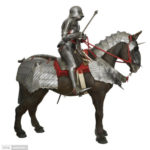Ever so often we stumble on some minor medieval news which does not merit a full article, but nevertheless, deserves a short notice.
The existence of this 13th-century copy of a key compendium on astronomy and mathematics was previously unknown. Islamic art specialist Romain Pingannaud explains what makes it so incredibly rare
 ‘In the world of ancient books and manuscripts, very often even the experts are unaware of the existence of important copies of key works. That was the case here,’ explains Romain Pingannaud, specialist in Islamic Art, of this 13th-century copy of a compendium of astronomical and mathematical treatises by Nasir al-Din al-Tusi(1201-1274). ‘This was an incredible surprise,’ he adds.
‘In the world of ancient books and manuscripts, very often even the experts are unaware of the existence of important copies of key works. That was the case here,’ explains Romain Pingannaud, specialist in Islamic Art, of this 13th-century copy of a compendium of astronomical and mathematical treatises by Nasir al-Din al-Tusi(1201-1274). ‘This was an incredible surprise,’ he adds.
Born in Tus, in former Anatolia (present-day Iran), al-Tusi was one of the medieval world’s most eminent scholars. Credited with having invented trigonometry, he wrote on a wide range of topics within mathematics and astronomy, as well as on logic and theology. He also famously founded the observatory at Maragha, Iran, in 1259, which sparked a major renaissance in Islamic astronomy.
This manuscript, offered on 26 April in the Art of the Islamic and Indian Worlds sale at Christie’s in London, is a compilation of al-Tusi’s writing on five subjects. Some are his original theories, while others are his explanations of the work of Greek scholars. One of the chapters, for example, is a commentary on Ptolemy’s major work, the Almagest.
Royal Armouries Collection in Leeds currently focus on the War of the Roses. Enjoy the Late Medieval Highlights in their collection
 The Gothic Armour dating from the late fifteenth century is currently on display on the cruciform in the War Gallery in Leeds. The armour is called ‘gothic’ presumably because it was thought reminiscent of medieval ‘Gothic’ architecture. This particular armour is of German origin, it is more symmetrical than other European armours. A popular form of a helmet in Germany was the sallet, this could be made from one piece with the sight cut into the front face or with a broad open face, over which a visor could be fixed. Sallets were often worn with a chin-shaped defence, called a bevor, although the sallet provided great protection, the bevor proved unpopular and there are many accounts of men slain in battle for not wearing their bevor or temporarily lowering it to help them breath. The Gothic Armour is currently on display together with a group of other weapons which were carried by soldiers, nobles and princes in this very bloody Late Medieval war.
The Gothic Armour dating from the late fifteenth century is currently on display on the cruciform in the War Gallery in Leeds. The armour is called ‘gothic’ presumably because it was thought reminiscent of medieval ‘Gothic’ architecture. This particular armour is of German origin, it is more symmetrical than other European armours. A popular form of a helmet in Germany was the sallet, this could be made from one piece with the sight cut into the front face or with a broad open face, over which a visor could be fixed. Sallets were often worn with a chin-shaped defence, called a bevor, although the sallet provided great protection, the bevor proved unpopular and there are many accounts of men slain in battle for not wearing their bevor or temporarily lowering it to help them breath. The Gothic Armour is currently on display together with a group of other weapons which were carried by soldiers, nobles and princes in this very bloody Late Medieval war.
Visit:
Royal Armouries in Leeds
Armouries Drive
Leeds, LS10 1LT United Kingdom
‘Arms and Armour of Late Medieval Europe’ by Bob Woosnam-Savage is available to purchase online and in the museum shop.
